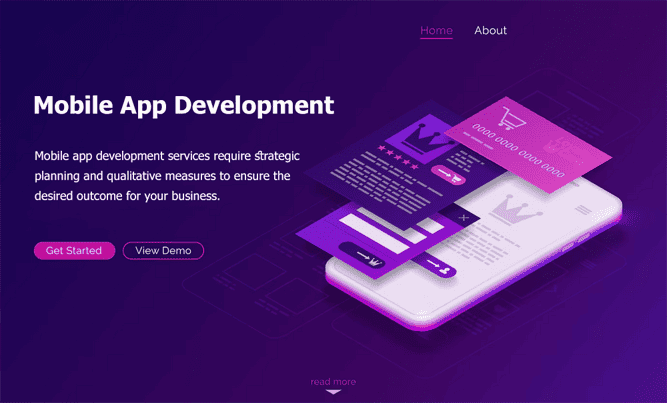
There is no denying the fact that mobile phones have reformed the way we accomplish our tasks at a faster rate. Be it ordering a favorite cuisine, booking a movie ticket, purchasing groceries, or making an online appointment with your doctor, mobile applications are providing great convenience to manage the work productively and advantageously more than we expected.
Thus, with the ever-growing popularity of mobile applications, businesses have found new opportunities to reach their target customers. And this is the reason, the demand for mobile app development is increasing day by day. According to the study by RiskIQ, there are more than 8.9 million mobile applications available, with 2.7 million apps at Google Play and 1.64 million apps at Apple’s App Store dominating the market.
Well, the mobile app development process can be daunting and time-consuming. Thankfully, there are proven steps to follow in the overall mobile app development lifecycle. In this blog, you will get to know about how developers create mobile apps from design to delivery and maintenance. To make it simple to understand, the entire mobile application development lifecycle is categorized into 6 key stages;
1. Initial Phase
When you have a unique idea for a business, it is imperative to invest some time in market study to ensure venture and future scope.
Determining the Purpose for Application Development
Successful mobile apps can solve several problems for users. Thus, it is important to figure out the purpose and key destinations for your mobile app development. Developers should focus on the problem statement and a brief about the present status, challenges, and solutions.
Market Research
While doing thorough research on the various domains and industries, gather feedback from individuals- agents, users, or organizations, who will benefit from your application. Additionally, distinguish your target audience to meet their expectations through a top-notch mobile app.
Competitor Analysis
It is the most crucial step to be followed in mobile app development strategies. It offers in-depth insights into what your competitors are doing to gain success through similar applications that you are also planning to launch with different objectives and unique features.
Building an MVP
Most businesses prefer MVP (Minimum Viable Product) development to benefit from its compatibility and code flexibility. Considering MVP before the designing and development phase helps to figure out the exact features you want in the application that will deliver better outcomes.
2. App Designing Phase
UI and UX are the two undeniable components that decide the success of your mobile application. It plays a critical role in the mobile app development lifecycle that helps to improve the engagement of your target users.
Aligning the Crucial Elements
Aligning the crucial elements such as data, interface, and functionalities is the foremost step in the designing phase of your mobile app development. After that, the technology stack and architecture are finalized to create the detailed application design.
Wireframing
The wireframe acts as a blueprint in the mobile app development lifecycle that defines the structure, content, and feature of your application. It is recommended to add this step in the design phase only as further steps of development are dependent on it.
Mockups Prototyping
Mockup is also known as a high loyalty plan, which is a delivery of a visual plan in the mobile application development lifecycle. While prototyping is a fast format for the proposed mobile application. It is explicitly needed if the idea is new and there’s a vulnerability in its application development.
UI and UX Design
With an application structure and model, it is important to use early feedback to ensure great UI and UX. Considering the trends UL design that complements your business objective is vital. The interface should be an incentive and easy to gain user attention.
3. App Development
This stage of the mobile application development life cycle involves the acknowledgment and coding of your app. It incorporates numerous phases such as creating a timeline for development with thorough coding, primer testing, and finalizing the application.
Front-End Development
The Front end development is the most significant step that users interact with while using your application. Your mobile app needs to enable APIs, that is the foremost step to be accomplished during the mobile app development lifecycle.
Feature Integration
After API integration, feature integration is done, which is the necessary step in the mobile application development lifecycle. Feature integration is done as per the business objectives and user requirements. The common features that should be added in-app include-
- Register Login
- Social Media Sharing
- Search Bar
- Push Notifications
- Ratings & reviews.
Along with this, some APIs are used for better user experience, such as analytics, CMS (Content Management Systems), Social media notification systems, and payment gateways.
Backend Technology Integration
Backend technology integration is deployed to achieve success in your mobile app development project. It involves server-side and data-based solutions to ensure a streamlined process in the organization.
4. App Testing and QA
Testing and QA are conducted by the team during the mobile app development lifecycle to avoid errors and other issues appearing in the future. It is executed based on certain models and cycles. The steps involved in the testing and QA phase are:
Usability Testing
As the name implies, usability testing is done to ensure convenience, adaptability, and benevolence with your mobile application.
Functional Testing
It suggests if the mobile application is well suited as per the business objective and delivers the expected outcomes.
Performance Testing
It involves checking the crucial aspects of mobile apps such as simplicity, speed, and quality, that lead to app optimization.
5. App Launch Phase
This is probably the last phase of the mobile app development lifecycle which indicates the market time of the app. Businesses can launch their application among a group of target users or launch it in online stores as a beta version to get an early user experience.
Pre-Launch Marketing
Pre-launch marketing can be compelling in order to gain desired results. Businesses can launch their mobile app through online media posts, web journals, and email templates.
Launching on Mobile App Distribution Platforms
And at last launch your mobile app with high-goal pictures on application stores following the current mobile app distribution policies.
6. Post-launch App Phase
The mobile app development life cycle doesn’t end at the launching phase, it continues with app upgrades and maintenance. The steps involved in the post-launching app process are-
App Store Optimization
With app store optimization, businesses can drive more traffic to their application and ultimately bring more business opportunities. In the ASO cycle, it is easy to focus on the keywords that your potential clients are using to search for an app like yours.
App Upgrade and Maintenance
This is the final phase of the mobile app development life cycle. Companies that provide app development services, deliver maintenance and support services as well to fix the bugs, react to the requests, change the framework, highlight the client’s demands, and develop the prevalence.
App Promotions
The success of any mobile app is dependent on the marketing strategy. With informed decisions and proper planning, businesses can make their applications highly impactful in the industry.
The Last Line
Mobile app development services require strategic planning and qualitative measures to ensure the desired outcome for your business. Deploying the above-mentioned steps in each phase of the mobile app development lifecycle will help you create a top-notch application for your business.



